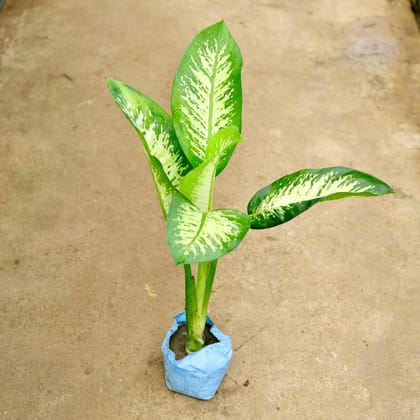Dieffenbachia Plant in 5 inch nursery bag
Dieffenbachia Plant in 5 inch nursery bag
Share
plantncr provides Cash on delivery, free delivery, next day delivery, best quality plants in low price ✨
Dieffenbachia, also known as Dumb Cane, is a tropical plant native to Central and South America. It belongs to the Arum family and is known for its large, showy leaves and ability to purify the air.
Climate Requirements
1. *Temperature*: Dieffenbachia plants prefer temperatures between 65°F (18°C) and 75°F (24°C).
2. *Humidity*: They thrive in humid environments, typically above 50% relative humidity.
3. *Sunlight*: Provide bright, indirect sunlight, but avoid direct sunlight, which can cause leaf scorch.
Watering Requirements
1. *Regular watering*: Water Dieffenbachia plants regularly, providing about 1-2 inches of water per week.
2. *Well-draining soil*: Ensure the soil drains well to prevent root rot.
3. *Allow soil to dry slightly*: Allow the top 1-2 inches of soil to dry slightly between waterings.
Medicinal Uses
1. *Air purification*: Dieffenbachia plants are known to purify the air by removing toxins and pollutants.
2. *Anti-inflammatory properties*: The plant contains anti-inflammatory compounds that may help reduce inflammation and pain.
3. *Traditional medicine*: Dieffenbachia has been used in traditional medicine to treat various ailments, including fever, rheumatism, and skin conditions.
Fertilizing Requirements
1. *Balanced fertilizer*: Feed Dieffenbachia plants with a balanced, water-soluble fertilizer during the growing season (spring and summer).
2. *High-nitrogen fertilizer*: Use a high-nitrogen fertilizer to promote healthy leaf growth.
Composting Requirements
1. *Compost tea*: Use compost tea as a foliar spray to promote healthy growth and prevent diseases.
2. *Mulching*: Mulch around the base of the plant to retain moisture and suppress weeds.
Caring Methods
1. *Pruning*: Prune Dieffenbachia plants regularly to maintain their shape, promote new growth, and encourage healthy leaf growth.
2. *Pest control*: Monitor for pests like mealybugs, spider mites, and scale, and treat promptly if necessary.
3. *Repotting*: Repot Dieffenbachia plants every 2-3 years to refresh the soil and provide a larger pot if necessary.
Planting Methods
1. *Seed planting*: Sow Dieffenbachia seeds directly in well-draining soil with a temperature range of 65°F (18°C) to 75°F (24°C).
2. *Nursery-grown plants*: Plant nursery-grown Dieffenbachia plants in well-draining soil, providing bright, indirect sunlight.
3. *Transplanting*: Transplant established Dieffenbachia plants carefully, avoiding root disturbance and providing sufficient water.
Common Problems and Solutions
1. *Root rot*: Caused by overwatering, treat by reducing watering frequency and improving soil drainage.
2. *Pests*: Treat infestations promptly with insecticidal soap or neem oil.
3. *Nutrient deficiencies*: Fertilize regularly, and consider adding micronutrients like iron or magnesium if necessary.
Interesting Facts
1. *Toxic sap*: Dieffenbachia plants contain toxic sap that can cause skin irritation and allergic reactions.
2. *Air-purifying abilities*: Dieffenbachia plants are known to purify the air by removing toxins and pollutants, making them a popular choice for indoor spaces.
3. *Low-maintenance*: Dieffenbachia plants are relatively low-maintenance, making them a great choice for busy people or those new to gardening.
By following these guidelines and understanding the specific needs of your Dieffenbachia plant, you'll be well on your way to growing a healthy and thriving plant that provides numerous benefits for air purification, medicinal uses, and aesthetic appeal.


